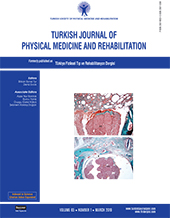Posturographic examination of body balance in patients with Chiari type I malformation and correlation with the presence of syringomyelia and degree of cerebellar ectopia
2 Department of Neurosurgery, İstanbul University, Cerrahpaşa Medical Faculty, İstanbul, Turkey DOI : 10.5606/tftrd.2019.2003 Objectives: We aimed to evaluate balance using the Tetrax Interactive Balance System (TIBS) in patients with Chiari type I malformation (CM-I) and to assess their fall risk with other clinical parameters.
Patients and methods: This cross-sectional, prospective study was conducted at physical medicine and rehabilitation outpatient clinics and neurosurgery department of a university hospital between December 2013 and December 2014. The study included a total of 36 patients (31 females, 5 males; mean age 40.6±10.0 years; range, 18 to 60 years) with CM-I. Dynamic balance was assessed using the Berg Balance Scale (BBS), and posturographic examinations were performed using the TIBS.
Results: The mean Fall Risk Index (FI) value was 42.4±29.8 and the mean BBS score was 55.5±1.5. The most common complaints were neck pain (94.4%), headache (88.9%), paresthesia (86.1%), fatigue (83.3%), and vertigo (80.6%). The mean tonsillar herniation below the foramen magnum was 8.7±3.8 (mm). Of the patients, 15 (42.85%) had syringomyelia. The degree of tonsillar ectopia was statistically significantly lower in patients with syringomyelia (p<0.05). The BBS scores were near identical among the patients with or without syringomyelia, although the FI values were lower in the patients with syringomyelia. Comparing cerebellar ectopia ≤9 mm versus >10 mm, the FI values were slightly higher in the patients with ectopia >10 mm, although there was no statistically significant difference in the FI or BBS values.
Conclusion: Our study results suggest that CM-I can decrease the body balance stability and, thus, increase the fall risk. Evaluation of balance in patients with CM using TIBS static posturography is a simple and effective technique.
Keywords : Balance; chiari type I malformation; fall risk; posturography; Tetrax Interactive Balance System
















